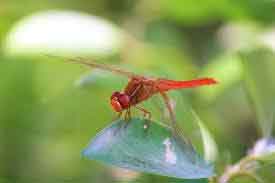Phylum Arthropoda is the largest animal group which constitutes the largest percentage of the world’s organisms. It is estimated that about 84% of all known species of animals belong to this phylum and number of known species vary between 1,170,000 and 5 to 10 million. Besides these, many arthropods are not yet unidentified. Some prominent groups of arthropods are insects, crabs, spiders, bees, ants, millipedes, shrimps, centipedes, etc. Among them, insects form the single largest class of phylum Arthropoda. According to the entomologist, globally there are over 10 quintillion insects on earth, of which, more than 300,000 species are Coleoptera, 180,000 species belong to Lepidoptera, over 90,000 dipteran species and over 100,000 species belong to Hymenoptera.
The term “Arthropoda” is derived from two Greek words ‘arthros’ meaning ‘joint’ and ‘podos’ meaning ‘leg’. Hence the word “Arthropoda” means “jointed legs”. Arthropods are protostomic, eucoelomic organisms and they have functional segmentation body with a pair of the jointed appendage. They also have a bilaterally symmetrical body with external chitinous cuticle. Some species of arthropods bear wings for aerial movement.
They are the successful animal groups which show a great variety of adaptations. Among them, some live in aquatic environments, some inhabit in terrestrial habitat and others are adapted for aerial habitats.
General Characteristic Features of Phylum Arthropoda
- They are triploblastic organisms with the bilaterally symmetrical body.
- They are found in aquatic, terrestrial and aerial environments.
- They have a paired jointed leg for locomotion with the segmented body (head, thorax, and abdomen.
- The body cavity is known as hemocoel which is filled with colorless blood.
- Their body has a chitinous exoskeleton and the head contains a pair of antenna and compound eyes.
- The digestive system is well developed and complete with a modified mouth for sponging, chewing, piercing, biting, siphoning, etc.
- They have an open type blood circulatory system with colorless blood. This system does not contain blood vessels and blood enters directly into the body chambers. In many cases, hemocyanin is present in blood as respiratory pigment which contains copper and blue color while hemoglobin occurs in few.
- They perform respiration through general body surface or gills or trachea, booklungs, and book gills. In this case, gills are a respiratory organ for crustacea, trachea for insects, Chilopoda and Diplopoda, booklungs for Arachnida and book gills for in king crab.
- They perform excretion Malpighian tubes, coxal glands or green glands. In this case, Malpighian tubules are an excretory organ for terrestrial form while green glands or coxal glands for aquatic forms.
- The nervous system is well-developed which consists of the brain and ventral nerve cord.
- They have different types of sensory organs which include antennae, sensory hairs, eyes (simple and compound), auditory organs and statocysts. In this case, sensory hairs are used for touch and chemoreceptor. Auditory organs are found in insects while statocysts are found in crustaceans as balancing organs.
- Sexes are unisexual organisms and show sexual dimorphism; fertilization is internal or external.
- They are oviparous or ovoviviparous type organisms with centrolecithal eggs and their development may be direct or indirect with distinct larval stages.
- During the development stage, meroblastic and superficial cleavage occurs. They also performance teloblastic growth.
You might also read: Phylum Mollusca: General Characteristics and Its Classification
Classification of Phylum Arthropoda
The phylum Arthropoda is divided into the following five sub-phyla:
- Trilobitomorpha
- Chelicerata
- Myriapoda
- Hexapoda and
- Crustacea
Sub Phylum-I: Trilobitomorpha [Gk. tri = three, lobos = lobe, morphe = shape = three-lobed form]
- Extinct marine arthropods are included in this subphylum.
- They were plentiful during the Paleozoic era.
- The body is divided into three regions: head or cephalon, trunk or thorax, and pygidium.
- Their body size ranges from 10 mm to 60 cm.
- Their exoskeleton or carapace was un-jointed which covered the head and pygidium.
- Head was distinct with a pair of compound eyes and antennae on the anterior part of the body.
- Post-antennal appendages were uniform, unspecialized and biramous.
- Legs were 8 segmented and anal opening was present on the last seg¬ment of the pygidium.
- The subphylum included about 4000 species under 5 classes. Among them, class Trilobita includes the largest number of species.
Examples: Triarthrus eatoni, Dalmanites limulurus
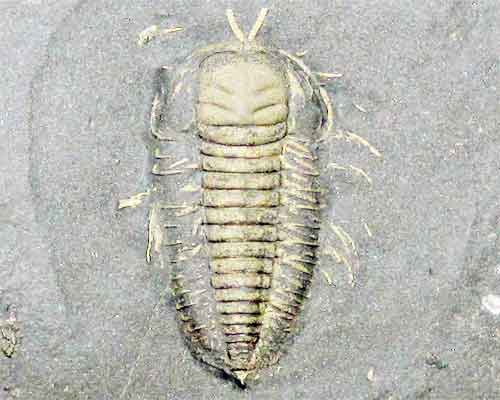
Triarthrus eatoni
Sub Phylum-II: Chelicerata (Gr. chele=claw, keros=horn)
- The body is divided into cephalothorax and abdomen with no distinct head. In this case, the abdomen has two regions such as anterior mesosoma and the posterior metasome with a telson.
- Cephalothorax bears six pairs of appendages with no antennae or antennules. Among them, the first pair appendage is chelicerae or feeding appendage.
- Chelicerates do not contain jaws or mandibles and each chelicera is jointed and bears a terminal chela.
- The abdomen bears 12-13 segments and a telson where the second abdominal segment bears genital aperture.
- Median simple eyes are present but in most cases compound eyes are degenerated
- This subphylum includes the sea spiders, arachnids, scorpions, and potentially horseshoe crabs.
- The development is usually direct.
Subphylum Chelicerata is again divided into the following two classes:
- Class-I: Xiphosura
- Class-II: Arachnida
Class I: Xiphosura (Gr. xiphos=sword, oura=tail)
- They are commonly called horseshoe crabs. All are bottom dwellers and inhabit marine environment.
- The cephalothorax is covered by a broad, smooth, and horse-shoe shaped carapace.
- One pair of chelicerae, four pairs of walking legs and one pair of pusher legs are present in the cephalothorax.
- They have lateral compound eyes and median ocelli.
- 5 pairs of book gills are present in the abdomen.
- At caudal region, an elongated, slender and pointed spine-like structure is present.
- In the abdominal region, the dorsal ridge is visible.
- Excretion occurs through a four-lobed coxal gland.
- Indirect development with a distinct larval stage (trilobite larva).
Examples:Limulus polyphemus (horseshoe crabs), Tachypleus gigas
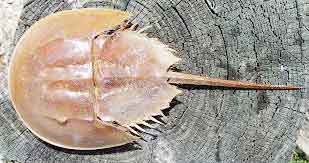
Limulus polyphemus
Class II: Arachnida (Gr. Arachne =spider)
- This class contains about 74,000 species. Among them, notable species are scorpions, ticks, mites, and spiders.
- Mostly they are terrestrial organisms and carnivorous.
- The body is divided into two regions: cephalothorax and abdomen.
- Cephalothorax bears 6 pairs of appendages. Among them, the first pair of preoral chelicerae, 2nd pair of pedipalps which are postoral and remaining four pairs of winged legs (Thoracic legs).
- In some species such as spiders, each chelicea contains fangs with poisonous glands.
- Generally, abdominal appendages are changed into book lungs but in spiders, it forms spinnerets while in scorpions it is modified into pectin.
- Most of the species do not contain telson but in scorpions, it is present as a sting.
- Excretion occurs through malpighian tubules, coxal glands or both.
- They show separate sexes; they lay centrolecithal and yolky eggs and their development is direct.
- Generally, the simple eye is present but sometimes degenerated compound eye is also found.
Examples:Heterometrus cyaneus,
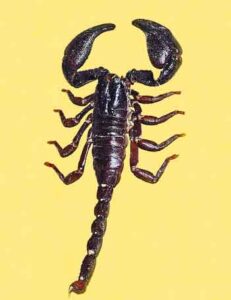
Heterometrus cyaneus
Sub phylum-Myriopoda
- This subphylum contains over 16,000 species, most of which are terrestrial and few are aquatic.
- They have an elongated body which is divided into head and trunk with numerous segments.
- The body length ranges from 0.5–300 mm.
- Generally, they live in humid environments where caves are available.
- They have simple eyes with one pair of antennae but in some cases, they have large and well-developed compound eyes (Scutigera).
- They perform respiration through spiracles which connect to a tracheal system.
- Mouth bears one pair of mandibles.
- Excretion occurs through Malpighian tubules.
Sub Phylum Myriopoda is divided into the following four classes:
- Class-I: Chilopoda (centipedes)
- Class-II: Diplopoda (millipeds)
- Class-III: Pauropoda
- Class-IV: Symphyla (pseudocentipedes)
Class-I: Chilopoda (centipedes)
- This class contains about 2800 species.
- The body is dorso-ventrally flattened with 15–173 segments.
- Each segment bears one pair of legs.
- They can live in most terrestrial environments including desert fringes.
- They have poisonous fangs (forcipules) which enable centipedes to kill and consume insects and other organisms.
- Their body is covered with a chitinous and non-calcified exoskeleton.
Example:Scolopendra galapagoensis, Scutigera coleoptrata (house centipede)
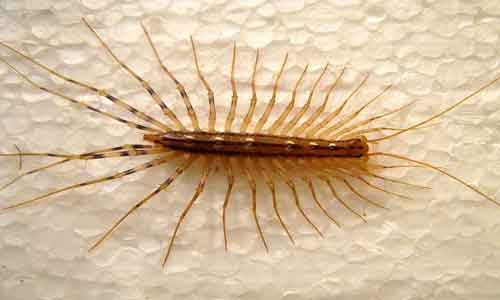
Scutigera coleoptrata
Class-II: Diplopoda (Millipedes)
- This class contains over 10000 species.
- They are relatively long-lived and can live up to 7 years.
- They have a cylindrical body with 11–90 segments.
- Each segment bears two pairs of legs.
- The body bears segmental plates which are constructed to roll up or coil for preventing them when threatened.
- They are slow-moving herbivore organisms which eat decaying leaves and wood.
- They have no poisonous fangs but they keep away predators by producing volatile poison from repugnatorial glands.
Example:Julus terrestris
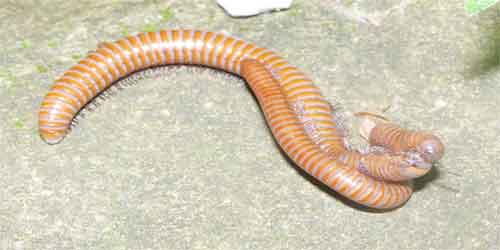
Julus sp
Class-III: Pauropoda
- This class contains around 830 species under 12 families.
- They are small and pale millipede-like organisms.
- They prefer to live in soil and leaf mold.
- They have a soft cylindrical body with 0.5 to 2 mm in length.
- Each body segment bears long sensory hairs.
- They have a distinctive anal plate.
- Each body segment bears ventral tracheal pouches which form apodemes.
- They have branching and segmented biramous antennae
Example: Pauropus amicus
Class-IV: Symphyla (pseudocentipedes)
- They are also known as pseudocentipedes or garden centipedes.
- They have a soft body with two regions: head and trunk.
- They can grow up to 30 mm in length.
- The head is long with segmented antennae.
- The trunk contains 15–24 segments, of which, ten or twelve segments contain legs.
- They can live up to four years or more.
- They prefer to consume decaying vegetation.
Example:Scutigerella immaculata (garden symphylan)
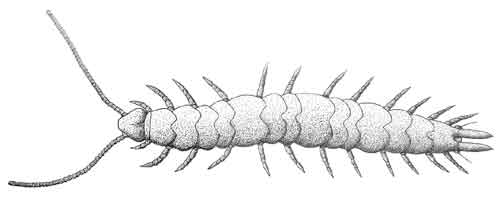
Scutigerella immaculata
Sub Phylum: Hexapoda
- They constitute the largest number of species of Arthropods which includes insects and wingless arthropods such as Collembola, Protura, and Diplura.
- Their body is divided into three regions: head, thorax, abdomen with six thoracic legs.
- The body length ranges from 0.5 mm to 300 mm.
- The head bears presegmental acron which usually contains eyes.
- The body is segmented and covered by chitinous cuticle called an exoskeleton.
- Thorax contains three pairs of jointed legs which give the name Hexapoda.
- They perform respiration through trachea and excretion through Malpighian tubules.
- The development includes metamorphosis.
Examples: Musca domestica (housefly), Lepisma saccharina (silverfish)
Subphylum Hexapoda is divided into the following twoclasses:
- Class-I: Insecta (insects)
- Class-II: Entognatha
Class-I: Insecta (insects)
- Class Insecta is the largest and diverse group under the phylum Arthropoda.
- They are also known as hexapod invertebrates.
- The word “insect” is derived from the Latin word insectum, meaning divided body.
- The body is divided into three parts: head, thorax, and abdomen.
- They have a chitinous exoskeleton.
- The body contains three pairs of jointed legs, one pair of compound eyes and one pair of antennae.
- They are mostly terrestrial and few are aquatic.
- The abdomen contains 7-11 segments without appendages.
- Respiration occurs through the trachea, gills, etc.
- Excretion performs through malpighian tubules.
Examples: Pieris balcana (Butterfly), Apis serana
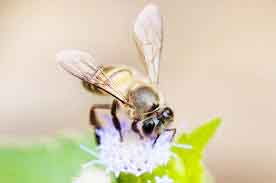
Apis serana
Class-II: Entognatha
- They are the wingless and ametabolous arthropods.
- They have entognathous mouthparts because all parts of the mouth are retracted within the head.
- Their mouthparts protected inside the head and they only project them during feeding.
- Most of them are herbivores or detritivores.
- They are small-sized (<10mm) and inconspicuous organisms.
Example:Entomobrya albocincta
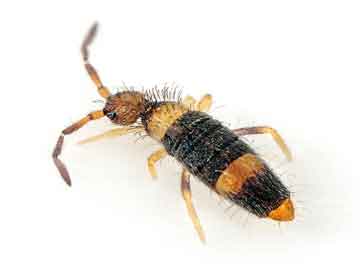
Entomobrya albocincta
Subphylum-V: Crustacea (Crusta: shell)
Class crustacean makes the large group of organisms under phylum Arthropoda. The notable crustaceans include the crabs, crayfish, lobsters, shrimp, barnacles, krill, copepods, ostracods, and mantis shrimp, etc. This class contains over 67,000 known species which are found in freshwater and sea. The American lobster is the largest crustaceans which can grow up to 20 kg in weight while the giant Japanese crab which has legs that can span up to 12 feet (3.7 meters).
- They have a segmented and bilaterally symmetrical body.
- The body is divided into three regions: Head, thorax, and abdomen.
- Generally, they are mostly aquatic some are terrestrial and very few leads parasitic life.
- Head and thoracic segments are fused to form a cephalothorax. In this case, cephalothorax is covered by the large carapace.
- Each segment of thorax and abdomen bear a pair of biramous appendages.
- Head bears two pairs of sensory antennae, two pairs of maxillae and one pair of mandibles
- They perform respiration through gills and general body surface.
- They perform excretion through a pair of green glands which is situated near the base of the antennae.
Classification of Crustacea
The subphylum Crustacea is divided into the following six classes;
- Class-I: Malacostraca
- Class-II: Maxillipoda
- Class-III: Branchipoda
- Class-IV: Ostracoda
- Class-V: Remipedia
- Class-VI: Cephalocarida
Class-I: Malacostraca
This class is the largest and extremely diverse class which contains over 40,000 species. The notable species include pill bugs, lobster, amphipods, crabs, scuds, crayfish, krill, shrimp, mantis shrimp, etc.
- They are plentiful in all marine habitats but also inhabit in freshwater and terrestrial habitats.
- They have a segmented body with up to 21 segments.
- The body is divided into three regions: head, thorax, and abdomen.
- The head is six segmented which contains two pairs of antennae, of which, the first pair of antennae are biramous.
- The body is covered with exoskeleton which is made up of chitin and calcium.
- They have stalked or sessile eyes.
Example:Lysmata amboinensis (Pacific Cleaner Shrimp), Nennalpheus sibogae
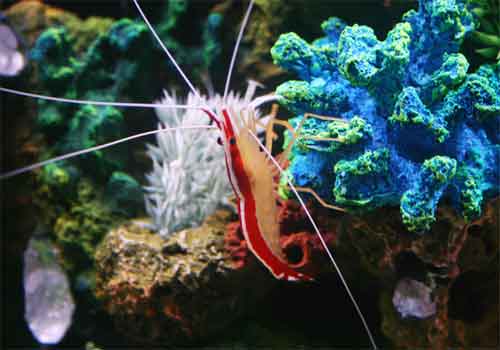
Lysmata amboinensis
Class-II: Maxillipoda
- This class contains over 23,000 described species.
- They are mostly small crustaceans and their body length ranges from 0.5-2.0 mm.
- The notable species include freshwater and marine copepods, marine barnacles, and a few additional groups like fish lice, etc.
- They have a reduced abdomen with few or no appendages.
- The head bears five pairs of appendages while the trunk is up to 11 segmented.
- They have single and simple median eye and antennules are uniramous.
Example:Tigriopus brevicornis, Aglaodiaptomus leptopus
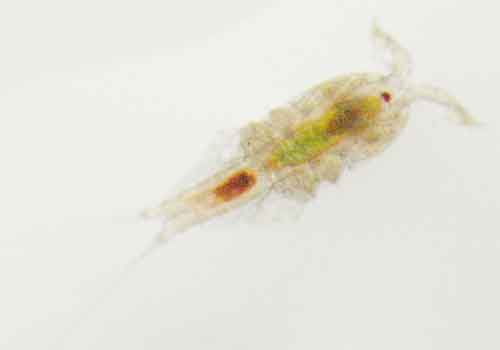
Tigriopus brevicornis
Class-III: Branchipoda
- This class contains roughly 800 species and comprises brine shrimp, tadpole shrimp, fairy shrimp, water fleas, etc.
- They chiefly inhabit in freshwater environments.
- They have compound eyes.
- Thoracic legs are flat, unbranched and edged with setae and have no distinct segments.
- Their body length ranges from 0.25 mm to 10 cm (fairy shrimp: Branchinecta gigas).
Example: Daphnia pulex, Artemia salina (brine shrimp)
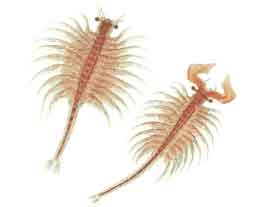
Artemia salina
Class-IV: Ostracoda
- This class contains about 800 described species and sometimes they are known as seed shrimp.
- They have a small, flattened body which is protected by a bivalve-like calcareous shell.
- The body is divided into two regions: head and thorax.
- Generally, they are small aquatic organisms and their body length ranges from 0.1 to 32 mm.
- The head bears five pairs of appendages but body bears only 1-3 pairs of appendages.
- They have two pairs of well-developed antennae which help to swim through the water.
Example:Herpetocypris reptans, Stenocypris hislopi
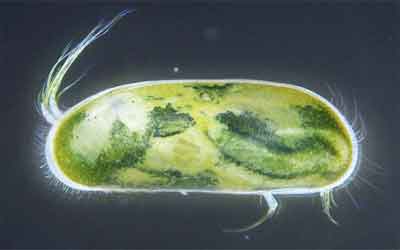
Herpetocypris reptans
Class-V: Remipedia
- This class contains about 17 species.
- The body is divided into head and elongated trunk.
- The trunk bears up to 32 similarly shaped segments.
- Generally, they have no eyes (except Enantiopoda).
- The trunk segments bear paddle-like appendages which are directed out to the side.
Example:Tesnusocaris goldichi , Cryptocaris hootchi
Class-VI: Cephalocarida
- It is a very small class which contains about 12 species.
- They have an elongated body with short head and their body size ranges from 2 to 4 mm in length.
- The body is divided into three regions: head, thorax, and abdomen.
- Thorax bears 8 segments that possess biramous, paddle-like appendages.
- The abdomen consists of eleven segments that do not contain any appendages.
- They have no eyes and the head bears two pairs of antennae and two pairs of jaws. In this case, the first pair of antennae are uniramous while the second pair is biramous.
- The tail end or telson bears one pair of long, thread-like, uniramous appendages.
Example:Chiltoniella elongate, Hampsonellus brasiliensis
Concluding Remarks
Arthropods live on land and in water and they are the source of food for many animals and human being. Many crustaceans species such as crabs, shrimp, prawns, lobsters, crayfish, etc are consumed by humans as protein sources. They are now cultured on a large commercial scale to meet the nutrition demands. Ecologically, they make food chain and also provide an important nutrition source for various animals such as fish, birds, mammals, and mollusks.

